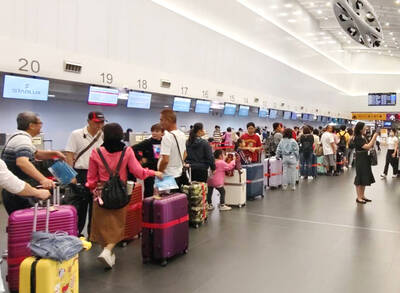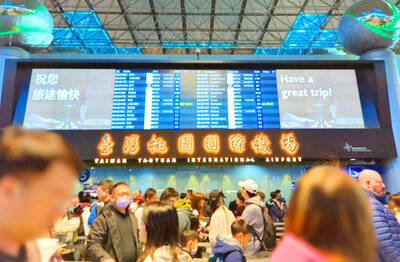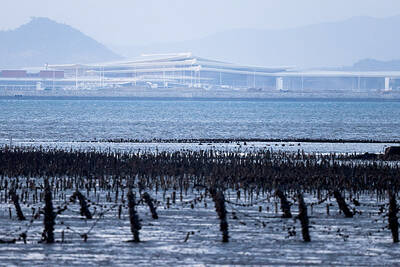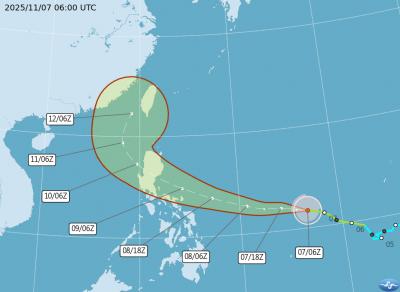Barely two weeks after splashing photographs of an aircraft carrier on the Internet, China’s state media on Monday published what it claimed were the first close-up pictures of a J-15 carrier-based fighter aircraft.
The day before, Web sites that focus on China’s military had run the same photographs, snapped outside the Shenyang plant in northeast China where the plane is being developed.
The J-15 Flying Shark has the folding wings, shortened tail cone and hardened landing gear that would allow it to serve on China’s first aircraft carrier, which is expected to start sea trials soon.
Some analysts said this was indisputable evidence of China’s growing mastery of military technology.
Like the aircraft carrier it will call home, the jet faces years of tests and refinement before it will formally enter service, military analysts said.
The photographs nevertheless suggest that the People’s Liberation Army, long notoriously secretive, is lifting some veils.
“The recent spate of releases of photographs of airplanes under development is a sign of relaxed control of military information in China,” Lan Yun, an editor at the Beijing-based Modern Ships magazine, said in an interview.
“It could be seen as a sign of more transparency of the Chinese military,” Lan said.
Lan and Andrei Chang, the Hong Kong-based editor of Kanwa Asian Defense Review, said the photograph indicated that the aircraft had passed factory tests and was now bound for flight-testing.
Internet posts by analysts and Chinese aviation enthusiasts pointed to a fighter crammed with the best technology China can produce: holographic “heads-up” instrument displays, advanced anti-ship radar and, Lan said, self-guiding missiles, in contrast to the gravity-controlled bombs and sight-guided missiles that largely populate China’s existing 3,200-aircraft fleet.
When it is deployed — probably sometime after 2015 — the J-15 will signal the dawn of a new ability by China to assert authority along its coastline and possibly into the South China Sea.
China’s aircraft carrier, still known by its old name Varyag, is a retrofitted version of a 1988 Soviet aircraft carrier that Chinese interests bought from Ukraine after the 1991 collapse of the Soviet Union, supposedly for conversion into a floating casino in Macao.
However, the Macao gambling license never materialized and, as many had suspected, the ship wound up elsewhere — in Dalian, where workers began a decade-long retrofit.
China is also reportedly working on a nuclear-powered aircraft carrier, which is scheduled for completion around 2020.
The J-15 has followed an even more tortuous route.
At the turn of the century, many news reports said the Chinese beseeched Moscow to sell them the Sukhoi-33, a 1980s Soviet fighter capable of landing on carriers. Moscow refused.
However, in 2001, the Chinese bought a Su-33 prototype from Ukraine and began a teardown to learn its secrets. The Russians were incensed.
Yet the J-15 unofficially unveiled this week, which externally seems a clone of the Su-33, in fact has been remade inside with Chinese improvements.
Lan said that advances in the plane’s outdated avionics and missile-guidance systems had made it a far more sophisticated version of the original Russian jet.
The J-15 is being compared in some quarters to the US F-18, a workhorse on US Navy carriers.
However, Lan said it had a shorter range, in large part because its takeoff method — flying off a ski-jump-style runway — dictated that it could carry less fuel than a comparable US jet, which is propelled off a flat carrier deck.
Flying a ski-jump requires considerable training. In February, a Ukrainian court convicted a Russian man of conspiring to give the Chinese details of a Crimean air base that had been used to train Su-33 pilots to take off from a carrier’s ski-jump ramp.
In Huludao, a navy installation in Liaoning Province, workers are said to have built a rough clone of the Crimea test center, complete with a ski ramp for ascending jets.
Contacted by the Taipei Times for comment, Rick Fisher, a senior fellow at the International Assessment and Strategy Center in Washington, said one should always be cautious with print stories about new Chinese weapons that only appear on Chinese Web pages.
In his view, Chinese state media have developed the habit of picking up material posted on Web pages and turning it into news stories so that Western media will propagate the message that “China is getting bigger and badder.”
“What we are seeing is that like the ‘unveiling’ of the J-20 in January, the Chinese propaganda department is getting into the habit of using Internet military enthusiasts to ‘project power’ in a propaganda sense,” he said.
That said, Fisher said there were reasons to consider that some of the programs detailed in Chinese media are real, he said.
The pictures come amid unconfirmed reports that China earlier this month flight-tested at a base in Inner Mongolia another aircraft based on the Su-33 design known as the J-18 Red Eagle.
However, unlike the J-15, the J-18 reportedly has vertical/short take-off and landing (VSTOL) capabilities akin to that seen on Lockheed Martin’s F-35 fighter. Both the J-15 and J-18 would be carrier-based.
ADDITIONAL REPORTING BY J. MICHAEL COLE

Three Taiwanese airlines have prohibited passengers from packing Bluetooth earbuds and their charger cases in checked luggage. EVA Air and Uni Air said that Bluetooth earbuds and charger cases are categorized as portable electronic devices, which should be switched off if they are placed in checked luggage based on international aviation safety regulations. They must not be in standby or sleep mode. However, as charging would continue when earbuds are placed in the charger cases, which would contravene international aviation regulations, their cases must be carried as hand luggage, they said. Tigerair Taiwan said that earbud charger cases are equipped

Foreign travelers entering Taiwan on a short layover via Taiwan Taoyuan International Airport are receiving NT$600 gift vouchers from yesterday, the Tourism Administration said, adding that it hopes the incentive would boost tourism consumption at the airport. The program, which allows travelers holding non-Taiwan passports who enter the country during a layover of up to 24 hours to claim a voucher, aims to promote attractions at the airport, the agency said in a statement on Friday. To participate, travelers must sign up on the campaign Web site, the agency said. They can then present their passport and boarding pass for their connecting international

UNILATERAL MOVES: Officials have raised concerns that Beijing could try to exert economic control over Kinmen in a key development plan next year The Civil Aviation Administration (CAA) yesterday said that China has so far failed to provide any information about a new airport expected to open next year that is less than 10km from a Taiwanese airport, raising flight safety concerns. Xiamen Xiangan International Airport is only about 3km at its closest point from the islands in Kinmen County — the scene of on-off fighting during the Cold War — and construction work can be seen and heard clearly from the Taiwan side. In a written statement sent to Reuters, the CAA said that airports close to each other need detailed advanced

Tropical Storm Fung-Wong would likely strengthen into a typhoon later today as it continues moving westward across the Pacific before heading in Taiwan’s direction next week, the Central Weather Administration (CWA) said. As of 8am, Fung-Wong was about 2,190km east-southeast of Cape Oluanpi (鵝鑾鼻), Taiwan’s southernmost point, moving westward at 25kph and possibly accelerating to 31kph, CWA data showed. The tropical storm is currently over waters east of the Philippines and still far from Taiwan, CWA forecaster Tseng Chao-cheng (曾昭誠) said, adding that it could likely strengthen into a typhoon later in the day. It is forecast to reach the South China Sea